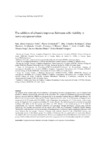Mostrar o rexistro simple do ítem
The addition of albumin improves Schwann cells viability in nerve cryopreservation
| dc.contributor.author | González Porto, Sara Alicia | |
| dc.contributor.author | Doménech, Nieves | |
| dc.contributor.author | González Rodríguez, Alba | |
| dc.contributor.author | Avellaneda Oviedo, Edgar Mauricio | |
| dc.contributor.author | Blanco García, Francisco J | |
| dc.contributor.author | Arufe, M.C. | |
| dc.contributor.author | Álvarez Jorge, Ángel | |
| dc.contributor.author | Sánchez Ibáñez, Jacinto | |
| dc.contributor.author | Rendal Vázquez, María Esther | |
| dc.date.accessioned | 2022-02-14T09:10:07Z | |
| dc.date.available | 2022-02-14T09:10:07Z | |
| dc.date.issued | 2018-04-26 | |
| dc.identifier.citation | González Porto SA, Domenech N, González Rodríguez A, Avellaneda Oviedo EM, Blanco FJ, Arufe Gonda MC, et al. The addition of albumin improves Schwann cells viability in nerve cryopreservation. Cell Tissue Bank. 2018;19(4):507-517 | es_ES |
| dc.identifier.issn | 1389-9333 | |
| dc.identifier.uri | http://hdl.handle.net/2183/29780 | |
| dc.description.abstract | [Abstract] The purpose of the current study was to establish a valid protocol for nerve cryopreservation, and to evaluate if the addition of albumin supposed any advantage in the procedure. We compared a traditional cryopreservation method that uses dimethyl sulfoxide (DMSO) as cryoprotectant, to an alternative method that uses DMSO and albumin. Six Wistar Lewis rats were used to obtain twelve 20 mm fragments of sciatic nerve. In the first group, six fragments were cryopreserved in 199 media with 10% DMSO, with a temperature decreasing rate of 1 °C per minute. In the second group, six fragments were cryopreserved adding 4% human albumin. The unfreezing process consisted of sequential washings with saline in the first group, and saline and 20% albumin in the second group at 37 °C until the crioprotectant was removed. Structural evaluation was performed through histological analysis and electronic microscopy. The viability was assessed with the calcein-AM (CAM) and 4′,6-diamino-2-fenilindol (DAPI) staining. Histological results showed a correct preservation of peripheral nerve architecture and no significant differences were found between the two groups. However, Schwann cells viability showed in the CAM-DAPI staining was significantly superior in the albumin group. The viability of Schwann cells was significantly increased when albumin was added to the nerve cryopreservation protocol. However, no significant structural differences were found between groups. Further studies need to be performed to assess the cryopreserved nerve functionality using this new method. | es_ES |
| dc.language.iso | eng | es_ES |
| dc.publisher | Springer | es_ES |
| dc.relation.uri | https://doi.org/10.1007/s10561-018-9700-7 | es_ES |
| dc.rights | This version of the article has been accepted for publication, after peer review and is subject to Springer Nature’s AM terms of use, but is not the Version of Record and does not reflect post-acceptance improvements, or any corrections. The Version of Record is available online at Springer Link. | es_ES |
| dc.subject | Cryopreservation | es_ES |
| dc.subject | Dimethyl sulfoxide | es_ES |
| dc.subject | Peripheral nerve injuries | es_ES |
| dc.subject | Serum albumin | es_ES |
| dc.title | The addition of albumin improves Schwann cells viability in nerve cryopreservation | es_ES |
| dc.type | info:eu-repo/semantics/article | es_ES |
| dc.rights.access | info:eu-repo/semantics/openAccess | es_ES |
| UDC.journalTitle | Cell Tissue Bank | es_ES |
| UDC.volume | 19 | es_ES |
| UDC.issue | 4 | es_ES |
| UDC.startPage | 507 | es_ES |
| UDC.endPage | 517 | es_ES |
Ficheiros no ítem
Este ítem aparece na(s) seguinte(s) colección(s)
-
INIBIC-TCMR - Artigos [102]
-
INIBIC- REUMA - Artigos [184]






